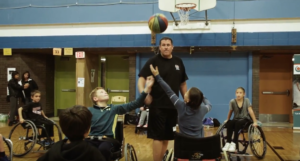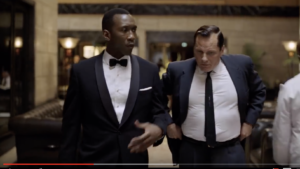But they’re not allowed to bark
April 19, 2019 • 2 Comments • Posted in blindness, parenting a child with special needs, public speaking, questions kids ask, Seeing Eye dogs, visiting schools
The day before Whit and I were in Highland Park, kids got to test out wheelchairs in the gym.
I’ve written about Patty O’Machel here before. A writer, special needs advocate and the mother of a teenager who has cerebral palsy, Patty has started her own business to encourage other schools to use the disability awareness curriculum she developed years ago for her daughter’s elementary school. Educating Outside the Lines launched last year, and already many Chicago suburban school districts have added the program to their curriculum. Prosthetic legs, wheelchairs and white canes can be scary to kids, so Patty developed her Educating Outside the Lines program to allow children to experience these “helping tools” hands-on and meet some people who use them. Example: before Whitney and I arrived in Highland Park for our school visits Tuesday, the third graders had used a Braille typewriter to write in Braille. Patty’s program serves to demystify differences, erase isolation, combat bullying.
It’s a great program for the kids who participate, and it’s been great for me, too — Patty has asked my Seeing Eye dog Whitney and me to visit schools we’ve never been to before! And that, in turn, is good news for you Safe & Sound blog readers who enjoy hearing questions kids ask during my school presentations. Here’s a sampling from the third-graders Whitney and I met at Braeside and Ravinia elementary schools in Highland Park, Illinois this past Tuesday:
- How do you get into a car?
- Do you remember what things looked like when you were a little kid and could still see?
- Do you have lots of friends who are blind?
- How do you swim if you can’t see where you’re going?
- Can you play sports if you’re blind?
- Did you ever drown?
- So after you get in the car, how do you drive, I mean, like, there are all those buttons so how can you tell those buttons and how can you know which one to push?
- How old are you?
- How do you get on the plane if pets aren’t allowed on planes?
- So if a friend comes to pick you up, how do you know if they’re there and it’s the right car?
Right then a boy named Alistair raised his hand. “I have an idea for you, Beth!” he exclaimed. “How about if you teach your dog to bark just once if its a friend? And then two barks would mean it’s a taxi, and three barks…”. What a sweet little guy. I hated to cut him off, but hey, we had to get going — there was still another school to visit. “Alistair! You’re a genius!” I gushed, making a point to thank him before breaking the bad news. “One problem, though,” I said with a sigh. “Seeing Eye dogs aren’t allowed to bark.”
Whitney and I are visiting two more elementary schools in Highland Park this Wednesday, so look for more questions in an upcoming post. In the meantime, you can check out this short video to see the positive impact Educating Outside the Lines has on the kids who participate, and Link to the Educating Outside the Lines web site for more information on ways to bring ability programs to schools.




